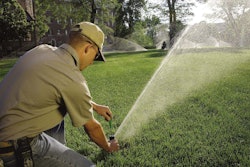
Pruning can be instrumental in controlling tree and shrub growth, as well as repairing damage.
The Lawn Doctor put together a few tips to help landscapers this season when it comes to pruning, including the best time to prune, why to prune, and how to prune.
Landscapers can reduce the need for frequent pruning by careful selection of the type of plant, making sure that your choice is suitable for the planting location and that the appearance of the fully grown plant will harmonize with your landscape plan.
You prune trees, shrubs and ornamental plantings to accomplish any of the following goals:
- To maintain an attractive, balanced shape.
- To increase flowering
- To limit the plant’s growth. Some vigorously growing plants can become overgrown and unsightly with age.
- To remove broken or disease-damaged portions
- To promote stronger growth of desirable limbs. For instance, plantings used in hedges may be topped off to promote fuller growth from the base.
- To direct or correct the growth of shade trees.
- To remove diseased or damaged tree limbs that may be a threat to people or property.
Minor pruning can be done at any time of the year; major pruning projects should be done in the early spring before new growth begins. Flowering bushes should be pruned shortly after blooms fall, and late-season pruning can reduce flower volume in the next season. Plants injured by storms, accidents, or vandalism should be pruned to remove damaged areas as soon as possible.
Pruning should be done on dry days when limbs and twigs are dry. After trimming diseased plants, tools should be disinfected to prevent transferring the infection to healthy plants. Work carefully to avoid damaging surrounding bark tissue or opening unnecessarily large wound areas, which enable disease organisms and insects to enter.
Avoid pruning when the temperature is below 20 degree Fahrenheit. Pruning in late fall or early winter will keep wounds open until spring, inviting desiccation.
Make sure you are using the right pruning tools for the job. Most pruning jobs can be done with hand pruners, lopping shears, pruning saws, pole pruners, or hedge shears. Each type of tool has a particular use – a scissor-action hand pruner can clip small twigs, while a pole pruner can get at high-hanging branches. Make sure that the tools are sharp and clean. Tools that are dull or under-sized do not provide clean cuts that heal rapidly.
That being said, when done correctly, pruning can help foster growth with shrubs and trees. In fact, the lawn care experts at Lawn Doctor have been noted saying that by implementing correct pruning procedures and practices, you can effectively facilitate the stronger growth of desirable limbs, remove damaged or diseased areas as well as maintain the balanced shape you are looking for.










